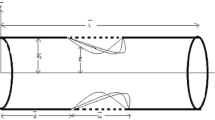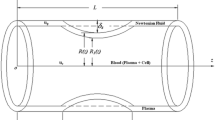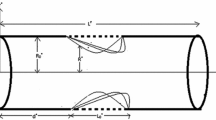Abstract
In the present study, an unsteady two-fluid model of blood through a tapered arterial stenosis with variable viscosity in the presence of variable magnetic field has been investigated. In this model, blood in the core region is assumed to be micropolar and plasma in the peripheral layer as Newtonian. Finite difference method is employed in solving the governing equations. The solutions for velocity, flow rate, wall shear stress and flow resistance are computed numerically. A comparison between the velocity profiles obtained by the present study and the experimental data is made and a good agreement between them is found. The model is used to study the effect of parameters such as taper angle, radially variable viscosity, hematocrit, the coupling number, the micropolar parameter, magnetic field and plasma layer thickness on physiologically important parameters such as wall shear stress distribution in the stenotic region and flow resistance. The results in the case of constant magnetic field and variable magnetic field are compared to study the effects of magnetic field on the flow of blood. It is found that the magnitudes of wall shear stress and flow resistance are higher in the case of variable magnetic field. It is important to note that the flow resistance is higher for magneto-micropolar fluid than the micropolar fluid. The wall shear stress decreases with increasing hematocrit parameter whereas flow resistance increases with hematocrit when the applied pressure gradient is held fixed. The model clearly shows the situation of a patient with a tapered arterial stenosis under feverish condition. Due care has been taken to compare the present theoretical results with the existing ones including experimental results and good agreement between them has been observed both qualitatively and quantitatively.













Similar content being viewed by others
Abbreviations
- \(\bar{z}\) :
-
Axial distance
- \(\bar{r}\) :
-
Radial distance
- \(\bar{t}\) :
-
Time
- \(\bar{R}_1(\bar{z})\) :
-
Radius of the central core region
- \(\bar{R}(\bar{z})\) :
-
Radius of the artery in the stenotic region
- \(\bar{k}(\bar{r})\) :
-
Rotational viscosity
- \(\bar{u}_c\) :
-
Axial velocity of the core fluid
- \(\bar{v}_c\) :
-
Radial velocity of the core fluid
- \(\bar{u}_p\) :
-
Axial velocity of plasma
- \(\bar{v}_p\) :
-
Radial velocity of plasma
- \(\bar{v}_{\theta }\) :
-
Rotational velocity
- \(\bar{j}\) :
-
Micro-gyration parameter
- \(\bar{p}\) :
-
Pressure
- \(\bar{H}_0^2(\bar{r})\) :
-
Variable magnetic field
- \(h_m\) :
-
Hematocrit
- \(m^2\) :
-
Micropolar spin parameter
- N :
-
Coupling parameter
- d :
-
Location of the stenosis
- \(n_1\) :
-
Shape of stenosis
- \(A_0\) :
-
Amplitude of steady pressure gradient
- \(A_1\) :
-
Amplitude of pulsatile pressure
- \({u_p}_0\) :
-
Initial velocity in the plasma region (without magnetic field)
- \({u_c}_0\) :
-
Initial velocity in the core region (without magnetic field)
- \({v_\theta }_0\) :
-
Initial rotational velocity (without magnetic field)
- \(I_0\) :
-
Modified Bessel function of zero order
- \(I_1\) :
-
Modified Bessel function of order 1
- \(I_2\) :
-
Modified Bessel function of order 2
- \(Q_c\) :
-
Flow rate in the core region
- \(Q_p\) :
-
Flow rate in the peripheral plasma region
- Q :
-
Total flow rate
- \(\bar{\mu }(\bar{r})\) :
-
Consistency function
- \(\bar{\mu }_c(\bar{r})\) :
-
Variable viscosity of the central core fluid
- \(\bar{\mu }_p\) :
-
Viscosity of the plasma
- \(\bar{\rho }_c\) :
-
Density of the central core fluid
- \(\bar{\rho }_p\) :
-
Density of plasma
- \(\bar{\sigma }\) :
-
Electrical conductivity of the fluid
- \(\beta \) :
-
Material constant
- \(\beta _1\) :
-
Constant in variable core viscosity
- \(\beta _2\) :
-
Constant in variable rotational viscosity
- \(\delta _s\) :
-
Maximum stenotic height
- \(\psi \) :
-
Taper angle
- \(\alpha _1\) :
-
Constant in variable magnetic field
- \(\tau _{zr}^A\) :
-
Asymmetric part of shear stress
- \(\tau _{rz}^S\) :
-
Symmetric part of shear stress
- \(\tau _w\) :
-
Wall shear stress
- \(\delta \) :
-
Plasma layer thickness
- \(\lambda \) :
-
Flow resistance
References
Bhargava R, Rawat S, Takhar HS, Beg OA (2007) Pulsatile magneto-biofluid flow and mass transfer in a non-Darcian porous medium channel. Meccanica 42:247–262
Bloch EH (1962) A quantitative study of the hemodynamics in the living microvascular system. Am J Anat 110:125–153
Bugliarello G, Sevilla J (1970) Velocity distribution and other characteristics of steady and pulsatile blood flow in fine glass tubes. Biorheology 7:85–107
Burton AC (1966) Physiology and biophysics of the circulation. Year Book Medical Publisher, Chicago
Caro CG (1981) Arterial fluid mechanics and atherogenesis. Recent Adv Cardiovasc Dis 2(Supplement):6–11
Chaturani P, Ponnalagarsamy R (1984) Analysis of pulsatile blood flow through stenosed arteries and its applications to cardiovascular diseases. In: Proceedings of the 13th national conference on fluid mechanics and fluid power, pp 463-468
Chaturani P, Ponnalagarsamy R (1986) Pulsatile flow of Casson’s fluid through Stenosed arteries with applications to blood flow. Biorheology 23:499–511
Chaturani P, Ponnalagarsamy R (1986) Dilatancy effects of blood on flow through arterial stenosis. In: Presented in Indian Soc. Theo. Appl. Mech. (ISTAM), December 1983 and published in proc. of 28th congress of ISTAM, pp 87–96
Cowling TG (1957) Magnetohydrodynamics. Interscience Publishers, New York
Eldesoky IM, Kamel MH, Hussien Reda M, Abumanndour Ramzy M (2013) Numerical study of unsteady MHD pulsatile flow through porous medium in an artery using generalized differential quadrature method (GDQM). Int J Mater Mech Manuf 1(2):200–206
Ellahi R, Rahman SU, Mudassar Gulzar M, Nadeem S, Vafai K (2014) A mathematical study of non-newtonian micropolar fluid in arterial blood flow through composite stenosis. Appl Math Inf Sci 8(4):1567–1573
El-Shahed M (2003) Pulsatile flow of blood through a stenosed porous medium under periodic body acceleration. Appl Math Comput 138:479–488
El-Shehawey EF, Elbarbary EME, Afifi NAS, El-Shahed M (2000) MHD flow of an elastic-viscous fluid under periodic body acceleration. J Math Sci 23:795–799
El-Shehawey EF, Eibarbary EME, Afifi NAS, El-Shahed M (2000) Pulsatile flow of blood through a porous medium under periodic body acceleration. Int J Theoret Phys 39:183–188
Eringen AC (1964) Simple microfluids. Int J Eng Sci 2:205–217
Eringen AC (1966) Theory of microfluids. J Math Mech 16:1–18
Formaggia L, Quarteroni A, Veneziani A (2009) Cardiovascular mathematics. In: Simulation and applications. Springer, Milan
Gaurav Varshney, Katiyar VK, Sushil Kumar (2010) Effect of magnetic field on the blood flow in artery having multiple stenosis: a numerical study. Int J Eng Sci Technol 2(2):67–82
Gold R (1962) Magnetohydrodynamic pipe flow. J Fluid Mech 13:505–512
Gupta AS (1960) Steady and transient free convection of an electrically conducting fluid from a vertical plate in the presence of a magnetic field. Appl Sci Res 9(1):319–333
Haldar K, Ghosh SN (1994) Effect of a magnetic field on blood flow through an indented tube in the presence of erythrocytes. Indian J Pure Appl Math 25:345–352
Ikbal MdA, Chakravarty S, Wong Kelvin KL, Mazumdar J, Mandal PK (2009) Unsteady response of non-Newtonian blood flow through a stenosed artery in magnetic field. J Comput Appl Math 230:243–259
Jeffords JV, Knisley MH (1956) Concerning the geometric shapes of arteries and arteriols. Angiology 7:105–136
Kang CK, Eringen AC (1976) The effect of microstructure on the rheological properties of blood. Bull Math Biol 38:135–158
Kinouchi Y, Yamaguchi H, Tenforde TS (1996) Theoretical analysis of magnetic field interactions with aortic blood flow. Bioelectromagnetics 17:21–32
Ku DN (1997) Blood flow in arteries. Annu Rev Fluid Mech 29:399
Kuipers NT, Sauder CL, Ray CA (2007) Influence of static magnetic fields on pain perception and sympathetic nerve activity in humans. J Appl Physiol 102:1410–1415
Kumar S, Kumar S, Kumar D (2009) Research note: oscillatory MHD flow of blood through an artery with mild stenosis. IJE Trans A Basics 22:125–130
Mandal PK (2005) An unsteady analysis of non-Newtonian blood flow through tapered arteries with a stenosis. Int J Nonlinear Mech 40:151–164
McKay JC, Prato FS, Thomas AW (2007) A literature review: the effects of magnetic field exposure on blood flow and blood vessels in the microvasculature. Bioelectromagnetics 28:81–98
Mekheimer KhS, Kot EI (2008) Influence of magnetic field and hall currents on blood flow through a stenotic artery. Appl Math Mech Engl Ed 29(8):1093–1104
Muthu P, Rathish Kumar BV, Peeyush C (2008) A study of micropolar fluid in an annular tube with applications to blood flow. J Mech Med Biol 8(4):561–576
Mustapha N, Amin N, Chakravarty S, Mandal PK (2009) Unsteady magnetohydrodynamic blood flow through irregular multi-stenosed arteries. Comput Biol Med 39:896–906
Mathur P, Jain S (2011) Pulsatile flow of blood through a stenosed tube: effect of periodic body acceleration and a magnetic field. J Biorheol 25:71–77
Pletcher RH, Tannehill JC, Anderson DA (2013) Computational fluid mechanics and heat transfer, 3rd edn. CRC Press, Taylor and Francis group, New York
Ponalagusamy R (1986) Blood flow through stenosed tube. Ph.D Thesis, IIT, Bombay
Ponalagusamy R (2007) Blood flow through an artery with mild stenosis, a two-layered model, different shapes of stenoses and slip velocity at the wall. J Appl Sci 7:1071–1077
Ponalagusamy R, Tamil Selvi R (2011) A study on two-layered model (Casson–Newtonian) for blood flow through an arterial stenosis: axially variable slip velocity at the wall. J Franklin Inst 348:2308–2321
Ponalagusamy R, Tamil Selvi R (2015) Influence of magnetic field and heat transfer on two-phase fluid model for oscillatory blood flow in an arterial stenosis. Meccanica, 50 (in press)
Ponalagusamy R (2015) Biological study on pulsatile flow of Herschel–Bulkley fluid in tapered blood vessels. In: Arbnia QTH (eds) Emerging trends in computational biology, bioinformatics, and systems biology-algorithms and software tools, ISBN: 978-0-12-802508-6. Elsevier Publishers, Boston, pp 39–51
Ponnalagarsamy R, Kawahava M (1989) A finite element analysis of laminar unsteady flows of viscoelastic fluids through channels with non-uniform cross-sections. Int J Numer Meth Fluids 9:1487–1501
Ramachandra Rao A, Deshikachar KS (1988) Physiological type flow in a circular pipe in the presence of a transverse magnetic field. J Indian Inst Sci 68:247–260
Rathod VP, Tanveer S (2009) Pulsatile flow of couple-stress fluid through a porous medium with periodic body acceleration and magnetic field. Bull Malays Math Sci Soc 32:245–259
Sankar DS, Lee U (2010) Two- fluid Casson model for pulsatile blood flow through stenosed arteries: a theoretical model. Commun Nonlinear Sci Numer Simul 15:2086–2097
Sharma MK, Bansal K, Bansal S (2012) Pulsatile unsteady flow of blood through porous medium in a stenotic artery under the influence of transverse magnetic field. Korea-Aust Rheol J 24(3):181–189
Singh S (2011) Numerical modeling of two-layered micropolar fluid through an normal and stenosed artery. Arch SID 24:177–187
Srikanth D, Kebede Taddesse (2012) Mathematical analysis of non-Newtonian fluid flow through multiple stenotic artery in the presence of catheter—a pulsatile flow. Int J Nonlinear Sci 13(1):15–27
Srivastava VP (1996) Two phase model of blood flow through stenosed tubes in the presence of a peripheral layer: applications. J Biomech 29:1377–1382
Sud VK, Suri PK, Mishra RK (1974) Effect of magnetic field on oscillating blood in arteries. Studia Biophysica 46:163–169
Tandon PN, Pal TS (1988) Applied magnetic field effects on pulsatile blood through a time developing stenotic tube. In: Proceedings of the 16th national conference fluid mechanics and fluid power
Vardanyan VA (1973) Effect of magnetic field on blood flow. Biofizika 18:491–496
Voltairas PA, Fotiadis DI, Michalis LK (2002) Hydrodynamics of magnetic drug targeting. J Biomech 35:813–821
Young DF (1968) Effects of a time-dependent stenosis on flow through a tube. J Eng Ind Trans ASME 90:248–254
Young DF (1979) Fluid mechanics of arterial stenosis. J Biomech EngTrans ASME 101:157–175
Young DF, Tsai FY (1973) Flow characteristic in models of arterial stenosis-I. Steady flow J Biomech 6:395–410
Acknowledgments
One of the authors S. Priyadharshini is thankful to the Ministry of Human Resource Development (MHRD), the Government of India for the grant of a fellowship through National Institute of Technology, Tiruchirappalli to carry out this work.
Author information
Authors and Affiliations
Corresponding author
Additional information
Communicated by Florence Hubert.
Rights and permissions
About this article
Cite this article
Ponalagusamy, R., Priyadharshini, S. Numerical investigation on two-fluid model (micropolar-Newtonian) for pulsatile flow of blood in a tapered arterial stenosis with radially variable magnetic field and core fluid viscosity. Comp. Appl. Math. 37, 719–743 (2018). https://doi.org/10.1007/s40314-016-0367-z
Received:
Revised:
Accepted:
Published:
Issue Date:
DOI: https://doi.org/10.1007/s40314-016-0367-z
Keywords
- Micropolar fluid
- Finite difference method
- Hematocrit
- Radially variable Magnetic field
- Stenosed artery
- Tapered artery




